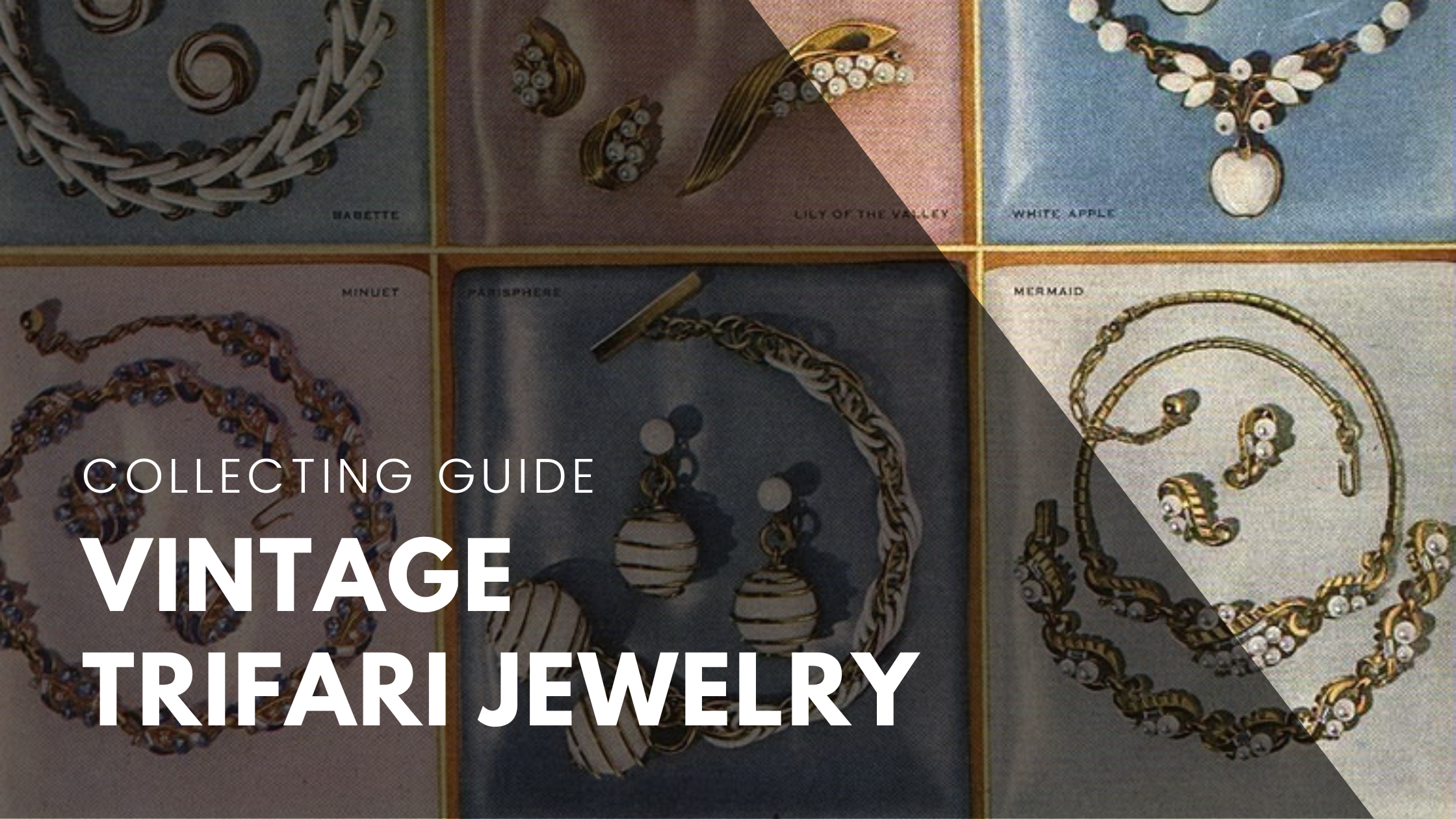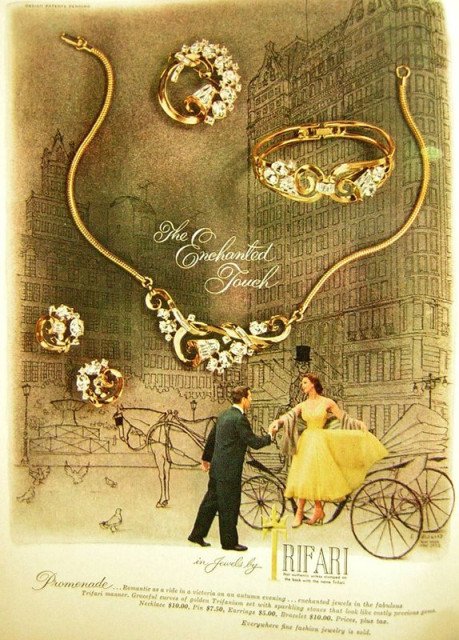Exploring the World of Vintage Trifari Jewelry
Trifari is a renowned vintage fashion jewelry brand known for its timeless elegance and innovative designs. Founded by Gustavo Trifari in 1910, the company gained widespread acclaim for its high-quality craftsmanship and attention to detail. Throughout its history, Trifari has been associated with iconic designs worn by influential figures, including First Lady Mamie Eisenhower.
For collectors, understanding Trifari's rich history and identifying characteristics is essential for distinguishing authentic pieces and appreciating their value. By delving into Trifari's design evolution, hallmark features, and collaborations with notable designers like Alfred Philippe, collectors can confidently navigate the vintage jewelry market and acquire cherished pieces that embody the brand's legacy of sophistication and style.
Trifari Jewelry Ad from 1952
History of Trifari
Trifari, a prominent name in vintage fashion jewelry, was founded in 1910 by Gustavo Trifari, an Italian immigrant with a background in goldsmithing. Initially established as "Trifari and Trifari" with his uncle Ludovico, the company underwent a significant transformation when his uncle left two years later. Gustavo Trifari continued the venture independently, laying the foundation for a celebrated jewelry brand.
In 1917, Leone Krussman and Carl Fishel joined the company, leading to a pivotal period of growth and innovation. The brand's name was changed to "KTF," with an enlarged "T" at the center to represent the Trifari legacy. Krussman assumed the role of commercial director, while Fishel oversaw sales operations, contributing to the company's expanding success.
Trifari's evolution was marked by collaborations with esteemed designers, most notably Alfred Philippe, who joined the company in 1930. Philippe's creative vision significantly shaped Trifari's signature style, characterized by intricate designs, impeccable craftsmanship, and timeless elegance. His tenure as the brand's creative mind lasted until 1968 when Trifari solidified its reputation as a leader in fashion jewelry.
Over the years, Trifari's designs evolved to reflect changing fashion trends while maintaining its distinctive aesthetic. From classic pearl necklaces to bold statement pieces adorned with colorful gemstones, Trifari jewelry showcased diverse styles that appealed to fashion-forward individuals across generations. Through innovative designs and enduring craftsmanship, Trifari continues to captivate collectors and enthusiasts with its timeless allure and artistic ingenuity.
Identifying Trifari Jewelry
Signature characteristics and design elements:
Intricate designs: Trifari jewelry is known for its elaborate and finely detailed craftsmanship, featuring delicate patterns and embellishments.
Rhinestones and faux gems: Many Trifari pieces incorporate rhinestones and faux gemstones, often arranged in elegant settings to mimic the look of fine jewelry.
Floral and nature motifs: Trifari frequently incorporates floral and nature-inspired motifs, including flowers, leaves, and animals like birds and butterflies.
Art Deco influences: Trifari's designs often reflect the Art Deco style, characterized by geometric shapes, symmetry, and streamlined forms.
Markings and hallmarks to look for:
Trifari logo: Look for the Trifari logo stamped or engraved on the jewelry piece. This may include variations of the brand name, such as "Trifari," "KTF," or "Trifari TM."
Patent numbers: Some Trifari pieces may feature patent numbers or other markings indicating the design's registration with the U.S. Patent Office.
Copyright symbols: Look for copyright symbols, such as © or circled C, which indicate that the design is protected by copyright law.
Materials commonly used in Trifari jewelry:
Rhodium and gold plating: Trifari often used rhodium and gold plating to create a lustrous finish on its jewelry pieces, providing durability and enhancing their aesthetic appeal.
Lucite and enamel: Trifari incorporated lucite and enamel accents into many of its designs, adding vibrant colors and textures to the jewelry.
Faux pearls and gemstones: Trifari frequently used faux pearls and gemstones, such as rhinestones and crystals, to create stunning jewelry with a luxurious look.
By familiarizing yourself with these signature characteristics, markings, and materials, you can confidently identify and appreciate Trifari jewelry pieces in your collection.
Trifari Jewelry Ad from 1957
Dating Trifari Jewelry
Recognizing different eras and periods of Trifari production:
Early years (1910s-1930s): Trifari's early production focused on fine jewelry designs influenced by Art Deco and Art Nouveau styles. Pieces from this era often feature intricate metalwork and delicate gemstone settings.
Mid-century period (1940s-1960s): Trifari experienced significant growth and popularity, producing various costume jewelry pieces. Designs from this era often feature bold, geometric shapes and colorful enamel accents.
Later years (1970s-present): Trifari continued to produce jewelry into the 1970s and beyond, with designs reflecting contemporary fashion trends. However, pieces from this period are generally less sought after by collectors compared to earlier eras.
Factors influencing the value and collectability of Trifari pieces:
Rarity: Limited edition or rare Trifari designs are more valuable and collectible than mass-produced pieces.
Designer collaborations: Trifari pieces designed by renowned artists or designers like Alfred Philippe are highly sought after by collectors.
Condition: The condition of the jewelry piece, including any damage or wear, can significantly impact its value.
Demand: Trends and consumer preferences can influence the demand for specific Trifari designs, affecting market value.
Tips for dating Trifari jewelry based on design, materials, and markings:
Design elements: Pay attention to the style and design elements of the piece, such as motifs, shapes, and construction techniques, which can provide clues to its production era.
Materials used: Trifari has used different materials in its jewelry pieces over the years. Familiarize yourself with the materials used in each era to help date the piece.
Markings and hallmarks: Look for Trifari logos, patent numbers, copyright symbols, and other markings on the jewelry piece, which can help identify its production period.
By considering these factors and using the tips provided, collectors can effectively date and evaluate Trifari jewelry pieces in their collections.
Collecting Trifari Jewelry Today
Where to Find Trifari Jewelry:
Vintage shops: Explore local vintage and antique stores, flea markets, and estate sales, where you may discover Trifari pieces, among other vintage jewelry offerings.
Online marketplaces: Browse online platforms such as eBay, Etsy, and Ruby Lane, where vintage jewelry sellers often list Trifari pieces for sale. Research sellers' reputations and carefully review product photos and descriptions.
Auctions: Keep an eye on auction websites and events, including live and online auctions hosted by reputable auction houses specializing in vintage jewelry and collectibles. Auctions can be excellent opportunities to acquire unique Trifari pieces.
Evaluating Condition and Authenticity:
Condition: Examine Trifari jewelry pieces closely for signs of wear, damage, or repairs. Look for missing stones, chipped enamel, or tarnishing, which may affect the piece's overall condition and value.
Authenticity: Verify the authenticity of Trifari pieces by checking for manufacturer markings, such as the Trifari logo or signature, and any accompanying hallmarks, patent numbers, or copyright symbols. Be wary of counterfeit or imitation pieces and consult reputable sources or experts for authentication.
Tips for Starting and Building a Trifari Jewelry Collection:
Research: Research Trifari jewelry designs, styles, and eras to familiarize yourself with the brand's history and distinctive characteristics. Identify specific pieces or collections that appeal to you and set collecting goals.
Budget: Establish a budget for your Trifari jewelry collection and prioritize pieces based on your preferences and budget constraints. Consider starting with more accessible pieces and gradually expanding your collection over time.
Diversify: Build a diverse Trifari jewelry collection by acquiring pieces from different eras, styles, and materials. Mix and match classic Trifari designs with rare or limited-edition pieces to create a well-rounded collection.
Resources for Further Research:
Books and publications: Explore books, magazines, and online articles dedicated to vintage jewelry collecting, including resources focused explicitly on Trifari jewelry. Look for authoritative guides and reference materials written by experts in the field.
Online communities: Join online forums, social media groups, and collector communities dedicated to vintage jewelry, where you can connect with fellow enthusiasts, share knowledge, and seek advice on Trifari jewelry collecting.
Museums and exhibitions: Visit museums and exhibitions that showcase vintage jewelry collections, including Trifari pieces, to gain insight into the brand's legacy and evolution. Attend lectures, workshops, or events hosted by jewelry experts and collectors for educational opportunities.
Trifari is significant in vintage fashion jewelry and is renowned for its timeless elegance, innovative designs, and exceptional craftsmanship. Understanding Trifari's rich history, identifying its signature characteristics, and learning to date its pieces are essential for collectors to appreciate and evaluate its value.
Collectors are encouraged to explore the diverse offerings of Trifari jewelry, from classic designs to rare and unique pieces, and to build their collections with care and passion. By delving into the world of Trifari, collectors can uncover treasures that showcase the brand's iconic style and embody the spirit of vintage fashion and craftsmanship.






